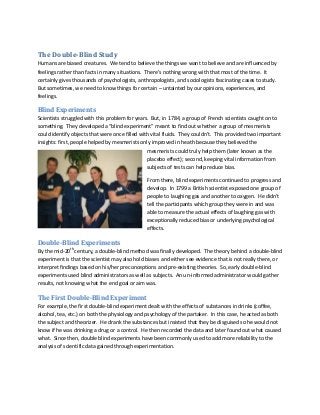
The double blind study
- 1. The Double-Blind Study Humans are biased creatures. We tend to believe the things we want to believe and are influenced by feelings rather than facts in many situations. There’s nothing wrong with that most of the time. It certainly gives thousands of psychologists, anthropologists, and sociologists fascinating cases to study. But sometimes, we need to know things for certain – untainted by our opinions, experiences, and feelings. Blind Experiments Scientists struggled with this problem for years. But, in 1784, a group of French scientists caught on to something. They developed a “blind experiment” meant to find out whether a group of mesmerists could identify objects that were once filled with vital fluids. They couldn’t. This provided two important insights: first, people helped by mesmerists only improved in heath because they believed the mesmerists could truly help them (later known as the placebo effect); second, keeping vital information from subjects of tests can help reduce bias. From there, blind experiments continued to progress and develop. In 1799 a British scientist exposed one group of people to laughing gas and another to oxygen. He didn’t tell the participants which group they were in and was able to measure the actual effects of laughing gas with exceptionally reduced bias or underlying psychological effects. Double-Blind Experiments By the mid-20th century, a double-blind method was finally developed. The theory behind a double-blind experiment is that the scientist may also hold biases and either see evidence that is not really there, or interpret findings based on his/her preconceptions and pre-existing theories. So, early double-blind experiments used blind administrators as well as subjects. An un-informed administrator would gather results, not knowing what the end goal or aim was. The First Double-Blind Experiment For example, the first double-blind experiment dealt with the effects of substances in drinks (coffee, alcohol, tea, etc.) on both the physiology and psychology of the partaker. In this case, he acted as both the subject and theorizer. He drank the substances but insisted that they be disguised so he would not know if he was drinking a drug or a control. He then recorded the data and later found out what caused what. Since then, double blind experiments have been commonly used to add more reliability to the analysis of scientific data gained through experimentation.
- 2. From large scientific centers in Heidelberg, Germany to clinical research centers in Utah, double blind studies have proven very effective methods for testing theories and gathering pure data. These tests have helped the quality of research from everything from medicine to physics to forensics. Recently, there have been calls for double-blind procedures in police photo lineup identifications. Witnesses are shown multiple pictures and asked to pick out the actual suspect. This is to test their memory and confirm the identity of the accused. However, subtle movements, actions, or particular treatment of photographs by the administrating officer may bias witness towards or against the correct photo. As such, not informing the officer or witness of which person is the accused would add validity and fairness to the process. Click here to learn more about more interesting double-blind experiments!